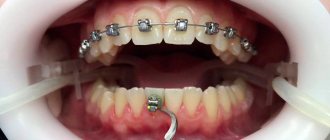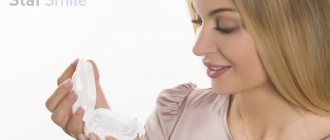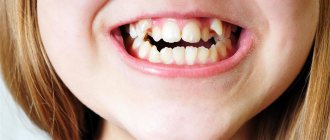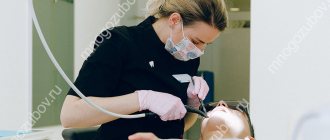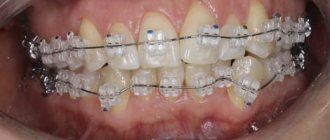If you are reading this article, it means that you are interested in improving your bite and are considering braces.
This shows that you have the determination to achieve a healthy, charming smile.
Here we have collected the questions that people most often write to us in messages.
I hope this changes your life for the better, just like it has changed the lives of thousands of other people.
Can adults get braces to correct their bite?
Anyone can correct a malocclusion, regardless of age. But in an adult, this process takes longer than in children, because skeletal growth has already stopped and hard bones are more difficult to form.
In addition, some oral health conditions may delay the installation of braces. For example, caries, periodontal disease, endocrine diseases.
Sometimes the effect of treatment is influenced by the presence of crowns and bridges. The treatment period starts from 1.5 years.
Slight crowding of lower incisors and canines
A prerequisite for installing braces only on the lower jaw is acceptable closure of the lateral sections of both jaws. But the doctor must determine in advance how much free space will be needed to straighten the lower crowded teeth with a brace system. And that's why.
The required space can be obtained in different ways. Expanding the row is unacceptable, since in this case it will lead to pathology - a violation of the closure of the jaws. What remains is the method of repairing dental crowns. Their contact surfaces are slightly ground - literally by 0.25 mm, which allows you to release 2-3 mm without harm to the teeth.
Thus, if there is a shortage of space up to 3 mm, it is possible to get by only with braces on the lower teeth. Otherwise, treatment will take place on two jaws.
Does teeth straightening hurt?
The installation of braces itself is painless, but requires patience because it takes about an hour.
For 7-10 days, teeth may hurt when biting. The body must get used to foreign objects. In general, you live your old life, you just notice pleasant changes in yourself.
Control visits are needed to correct the process and form the correct position of the teeth. Usually after changing the arch the pain goes away within 3-7 days. It all depends on individual sensitivity.
For some, wearing braces is only unpleasant, for others, on the contrary, it is painful, and some do not feel anything.
Is it possible to get braces instead of implants?
Moving adjacent teeth into the socket of the removed one is a common alternative to implantation. In terms of timing and price, these procedures differ little. Not all orthodontists undertake such treatment; experience and skills are required. In our Center, orthodontic treatment is used to replace a lost tooth, but the choice of method depends on:
- number of missing units - the distance to which adjacent teeth will need to be moved is estimated;
- location of the defect - frontal or chewing zone;
- the age and health of the patient - the possibility of performing an implantation operation and the effectiveness of orthodontic treatment are assessed;
- quality and quantity of bone tissue in the area of missing teeth - if there is not enough bone, bone augmentation is carried out during implantation; installation of braces is not always possible in such a situation.
Braces allow you to avoid implantation if one of the distant dental units (molar or premolar) is missing. The teeth adjacent to the missing one move and close the gap. But the method is not suitable if the frontal unit is removed, since the front teeth differ in shape. In this case, implantation will be required, which can be combined with the installation of braces to correct the dentition.
If the patient already has braces installed and a tooth needs to be removed, existing structures are used.
Related articles:
- Center guarantees
- Our advantages
- Press about us
Do braces make it difficult to eat?
Once installed, you will need to learn how to eat in them. This period takes on average 3-7 days.
At this time, give preference to soft and liquid foods. Cut fruits and vegetables into small pieces. Avoid fibrous and sticky foods.
Over time, you will be able to eat almost everything except Coca-Cola (can dissolve glue), hard foods (nuts, crackers, chocolate) and sticky sweets (chocolate, cookies or caramel bars). You should also not chew gum.
How often should inspections be carried out?
Every 1-2 months, it all depends on the defect and the individual structure of the patient’s teeth. During the visit, the orthodontist checks the success of the treatment and sets a vector for the arch, which determines the movement of teeth in the right direction.
Missing follow-up visits may negate the effect of previous treatment. You are also required to visit a hygienist every six months.
Braces, whether external or internal, need to be worn for an average of 1.5 years. But determining more precise timing depends on the initial situation and age of the patient. Sometimes it takes 2 years to eliminate a defect.
When are aligners installed?
- Trema, diastema;
- crowding of teeth (up to 6 mm);
- shortening or lengthening of the incisors (vertical anomalies of occlusion);
- rotation (wrong position) of the dental unit;
- the tooth deviates forward and backward;
- upcoming prosthetics or implantation.
The duration of treatment with aligners depends on the severity of the disorder. The course of correction can take from 8 months to 2 years or more. Each design has an individually specified trajectory of the action of weak forces on the dental units. One device displaces an abnormally located tooth by 0.2-0.3 mm. How many correctors are required for a set depends on the situation - the simpler the problem, the fewer aligners are needed.
The first pair of devices corresponds to the initial clinical picture; each subsequent pair includes adjustments to change the position of the teeth. The last pair displays the treatment result.
What to do if the bracket comes off?
In itself, this happens quite rarely, only in cases of severe crowding of teeth, since the arch puts a lot of pressure on the dentition and the lock falls off. Another option is if the patient is a nut or other solid food lover.
If you find a broken bracket, contact your orthodontist immediately. Otherwise, the teeth will begin to gradually move to their original position. Also remove elastic bands if you wear them.
The doctor sees patients with unstuck braces out of turn. It takes about 5 minutes to glue a new lock.
It also happens that the archwire flies out of the bracket grooves. You can try to get it back yourself. However, this should be done extremely carefully, without damaging the adjacent locks.
Under what conditions are braces used? are they used locally?
Partial braces are indicated for use in certain dental conditions. Namely, the closure of the molars must be correct, as well as the placement of the canines. Such ideal condition of the dentition is very rarely observed. Therefore, most often orthodontists use braces for the entire dentition for correction. However, partial use of braces is possible for the following pathologies:
- Noticeable interdental spaces;
- Incorrect tooth inclination;
- The tooth protrudes from the dentition;
- Incorrect rotation of the tooth;
- Slight curvature that disrupts the dentition.
All this can only be noticed with a certain dental examination, which involves visual and manual examination of the oral cavity, taking impressions, and then making models of the dentition from plaster. An x-ray and possibly a computed tomography scan are also needed to give an idea of the condition of the teeth and jaws. Only after diagnostic procedures can you confidently select one or another braces system.
How to brush your teeth with braces?
This is where a traditional toothbrush and toothpaste don't serve their purpose. Therefore, you will need to buy a special orthodontic brush, brushes and floss from the pharmacy. You can also use an oral irrigator if you wish.
This way you can effectively clean your teeth and the area around the locks. Teeth should be thoroughly brushed after each meal, because food debris is deposited on braces, which contributes to the development of caries and does not look aesthetically pleasing. We have repeatedly encountered patients whose teeth are more well-groomed than those of a person without braces.
Night braces
Braces are non-removable structures that are used to correct bite pathologies for 1–2 years. Such systems are installed by the attending orthodontist and during treatment, only he can remove them. Removable systems in orthodontics have names: aligners (aligners), plates and orthodontic trainers (later we will analyze each type separately). Such systems differ from braces in that they do not require continuous wearing. The design can be put on and taken off independently when circumstances require it.
Night guards or plates can correct problems with malocclusion only in the early stages of its development, therefore they are most often prescribed to children under 12 years of age. When the dentition is fully formed, such structures will not be able to correct the incorrect position of the teeth and make a serious bite correction.
Mouthguards are worn at night and for several hours during the day. So that the child does not feel discomfort and overcomes the psychological barrier more easily, manufacturers offer designs of various colors and shapes. These can be completely transparent or covered with glitter systems in the form of elephants or hearts.
Orthodontic night structures are divided into single-jaw or double-jaw. More details:
- Single-jaw – worn only on the upper or lower dentition. They have lost their popularity due to their low effectiveness in correcting malocclusion.
- Double-jawed - put on both jaws. They promote the proper development of a child’s jaw, and are also used to wean a child from bad habits (for example, biting nails or grinding teeth). Helps in the formation of the correct bite.
In some cases, night systems are also used for adults. Minor defects in the bite, small tooth rotation, small interdental space, or to consolidate a positive result after bite correction with braces.
The main question for all patients. Can night braces affect your sleep?
The orthodontic structure is made in such a way as not to interfere with the functioning of the respiratory organs and not cause pain.
Are braces the last stage of orthodontic treatment?
After removing braces, you need to consolidate the effect of straightening your teeth. For this purpose, retainers are made that will protect teeth from returning to their original place.
There are two types of retainers:
- Removable – transparent, plastic mouth guards. Used only at night or during a certain period.
- Non-removable - made of metal. They are installed on the back surface of the teeth using special composite materials.
The decision on the best method is made by the orthodontist. The aligners must be worn at all times during the first month, removed only for eating and brushing your teeth. On average they are worn for 2 years.
While wearing retention devices, you must visit a doctor every 3-6 months.
Types of removable bracket systems
As noted earlier, removable night structures are divided into several types. More details about each of them:
- Mouthguards (caps or caps) – made of polymers or non-oxidizing metal using 3D computer modeling technologies, used in orthodontic treatment. Mouthguards are made individually for each patient, depending on the existing bite problems. First, an impression is made of the dentition and with its help a whole set of aligners is created. Each product differs from the previous one with a slight difference in order to gradually move the tooth into the correct position. One mouthguard is used for 14–20 days, after which it is changed to the next unit.
- The plates are removable structures that can only be used at night. In orthodontics, they are often used to treat various pathologies in the development of the jaw in children. They promote the correct construction of the dentition, the correct formation of the carpal tissue of the jaw, and are also used for forced expansion of the palate. The plates are made individually according to the cast model. They are held on the teeth using thin wire hooks. They can be easily removed for eating or brushing teeth, after which they can be put on independently. When the plate is intended to straighten teeth, special springs, arms and hinges are mounted into its frame. If the plate is used to expand the jaw of a child, an expansion screw is inserted, which is located between the halves of the structure. For children they are made in different colors.
- Orthodontic trainers are made using elastic silicone, which makes them comfortable to use. They have a universal size and do not require correction while wearing. Trainers are installed overnight. Easily fits in the child's mouth. Despite the fact that swallowing the trainer is excluded, the baby should still be under the supervision of an adult. It is used to eliminate excess pressure from the tongue, cheeks and labial muscles on the rows of teeth, separating them from each other and normalizing the correct position. Thus, breathing, swallowing functions, the position of the tongue are normalized, and the dentition is placed in the correct relationship. The result of the impact of orthodontic trainers is that the child’s bite is corrected, all functions of the jaw muscles are normalized, the teeth take the correct position, the correct growth of the jaw is stimulated, which is why facial features are improved.
All three types of removable braces will help the child get rid of such bad habits as licking the gums with the tongue or putting it in between the teeth, finger sucking and mouth breathing. The child’s teeth are straightened even during the period when the bite changes and this allows one to avoid orthodontic treatment in the future, which means eliminating the possible removal of healthy molars.
Can you continue to live with crooked teeth?
Crooked teeth are more vulnerable to tooth decay and periodontal disease. If teeth grow incorrectly, their surfaces become excessively worn down when eating, which worsens the malocclusion. Therefore, sometimes it leads to serious diseases of the temporomandibular joints.
In addition, if you suffer from frequent headaches, chondrosis, or have tinnitus, it is better to check your bite.
Question answer
Is it always possible to use braces to move teeth to the place where they were removed?
If one tooth is missing, you can do without implantation. But usually this is only possible if there is a shortage of chewing units (provided there is sufficient bone tissue). They differ little in function and form. If there are missing front teeth, implantation will be required. Frontal units vary in size and shape; their displacement will cause an aesthetic defect in the smile area.
Levin Dmitry Valerievich
Maxillofacial surgeon, chief physician of the Center
Braces hurt the oral cavity, what should I do?
After installing braces, each patient receives wax for locks from the orthodontist. At the very beginning, it is worth applying it to the entire system, because the mucous membrane in the oral cavity is not yet accustomed to contact with foreign objects.
Abrasions and wounds heal very quickly. Their healing can be accelerated by using agents that promote the healing of wounds in the oral cavity.
Removable braces: pros and cons
Removable mouthguards, trainers or plates have a number of advantages, namely:
- due to the tight fit to the teeth and the transparency of the material used, they become invisible to others;
- quick adaptation and absence of discomfort;
- easy hygiene procedures (mouth guards can be easily removed and put on independently);
- the possibility of wearing the structure to school-age patients, which allows the procedure for correcting the bite to be carried out at the stage of its formation;
- are worn 11–15 hours a day, which makes it possible to go out into public places without wearing plates;
- makes it possible to wean a child from bad habits that can affect the formation of malocclusion;
- well suited for children who refuse to walk with fixed structures;
- specially inserted screws into the plates allow you to slowly and painlessly expand the jaw bones;
- help to consolidate the result obtained after correcting malocclusions with non-removable braces, protecting the teeth from returning to their original location.
The disadvantage of removable systems is the impossibility of treating bite pathologies with large deviations. Treatment with these types of orthodontic structures is not limited to the age category of the patient, but is more often used to correct pathologies in children.
